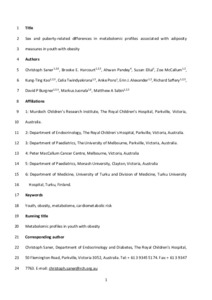Sex and puberty-related differences in metabolomic profiles associated with adiposity measures in youth with obesity
Ahwan Pandey; Matthew A. Sabin; Celia Twindyakirana; Richard Saffery; Zoe McCallum; Markus Juonala; Anke Pons; Christoph Saner; David P. Burgner; Erin J. Alexander; Susan Ellul; Kung-Ting Kao; Brooke E. Harcourt
https://urn.fi/URN:NBN:fi-fe2021042823417
Tiivistelmä
Background
Specific patterns of metabolomic profiles relating to cardiometabolic disease are associated with increased weight in adults. In youth with obesity, metabolomic data are sparse and associations with adiposity measures unknown.
Objectives
Primary, to determine associations between adiposity measures and metabolomic profiles with increased cardiometabolic risks in youth with obesity. Secondary, to stratify associations by sex and puberty.
Methods
Participants were from COBRA (Childhood Overweight BioRepository of Australia; a paediatric cohort with obesity). Adiposity measures (BMI, BMI z-score, %truncal and %whole body fat, waist circumference and waist/height ratio), puberty staging and NMR metabolomic profiles from serum were assessed. Statistics included multivariate analysis (principal component analysis, PCA) and multiple linear regression models with false discovery rate adjustment.
Results
214 participants had metabolomic profiles analyzed, mean age 11.9years (SD3.1), mean BMI z-score 2.49 (SD +/- 0.24), 53% females. Unsupervised PCA identified no separable clusters of individuals. Positive associations included BMI z-score and phenylalanine, total body fat % and lipids in medium HDL, and waist circumference and tyrosine; negative associations included total body fat % and the ratio of docosahexaenoic acid/total fatty acids and histidine. Stratifying by sex and puberty, patterns of associations with BMI z-score in post-pubertal males included positive associations with lipid-, cholesterol- and triglyceride-content in VLDL lipoproteins; total fatty acids; total triglycerides; isoleucine, leucine and glycoprotein acetyls.
Conclusion
In a paediatric cohort with obesity, increased adiposity measures, especially in post-pubertal males, were associated with distinct patterns in metabolomic profiles.
Kokoelmat
- Rinnakkaistallenteet [19250]
